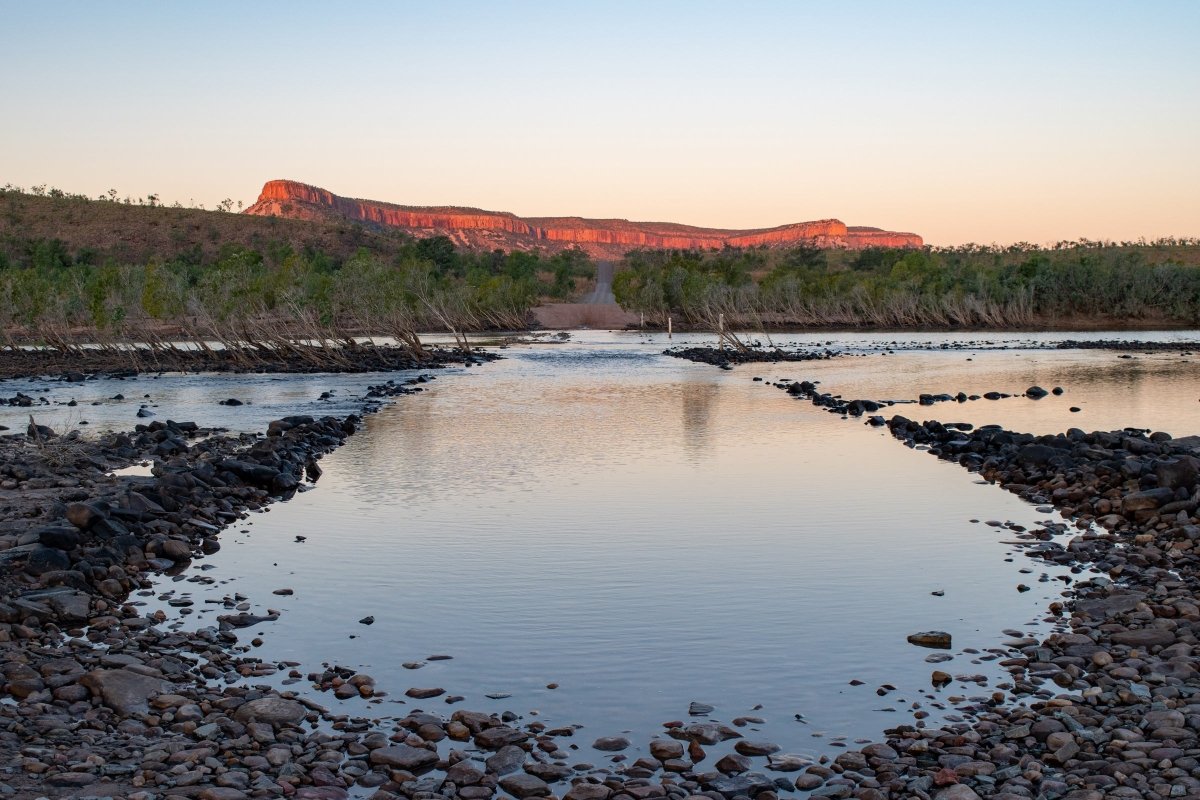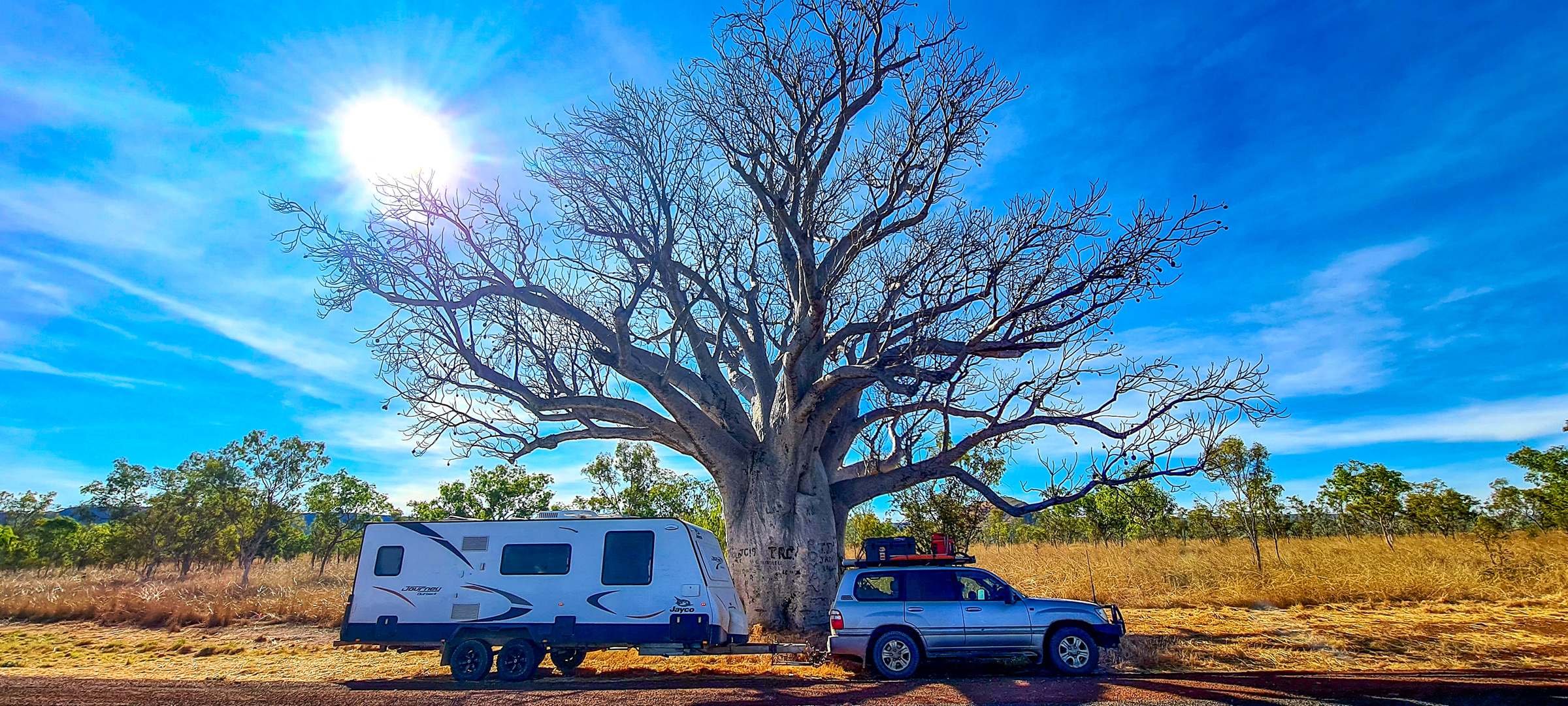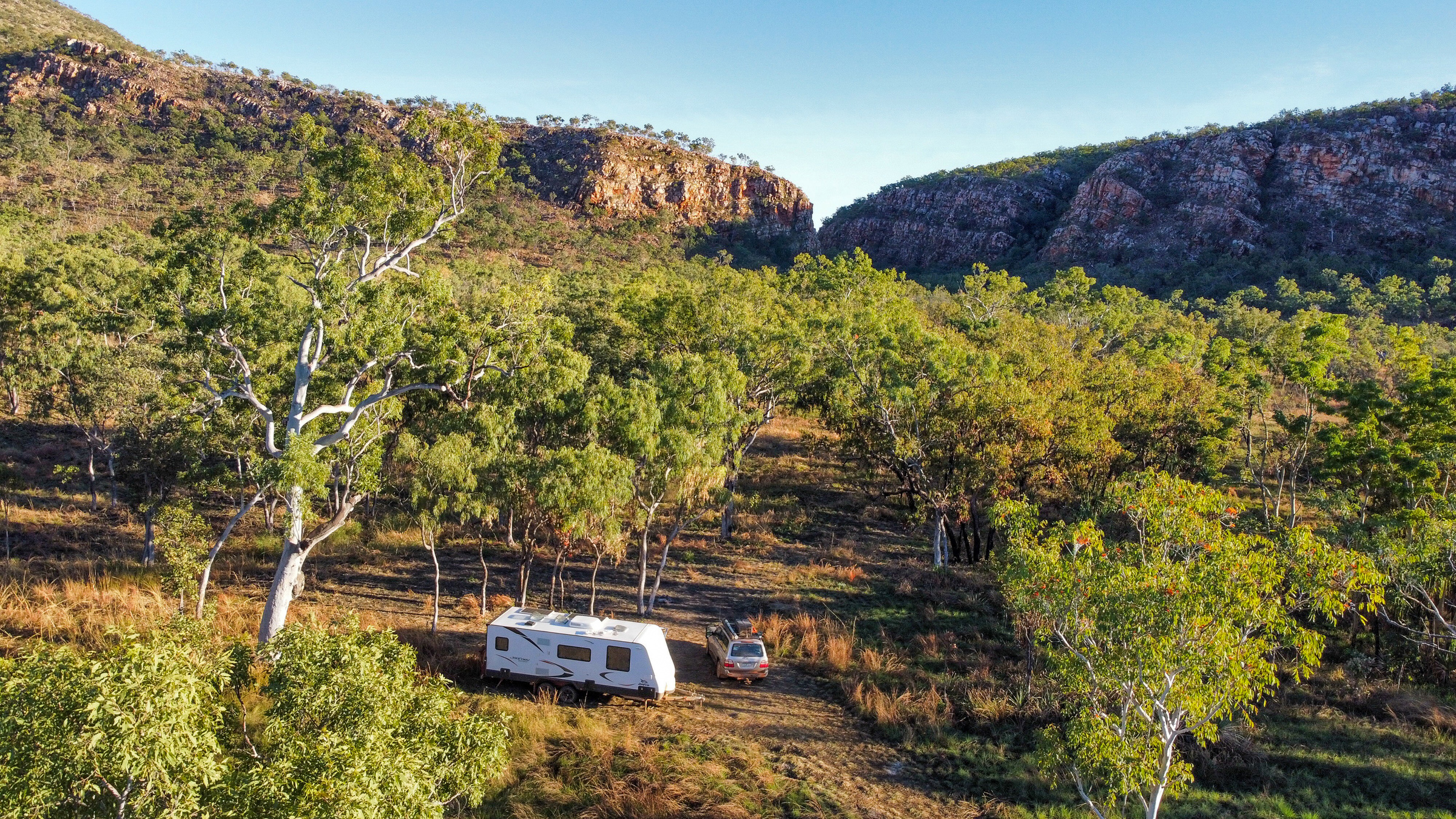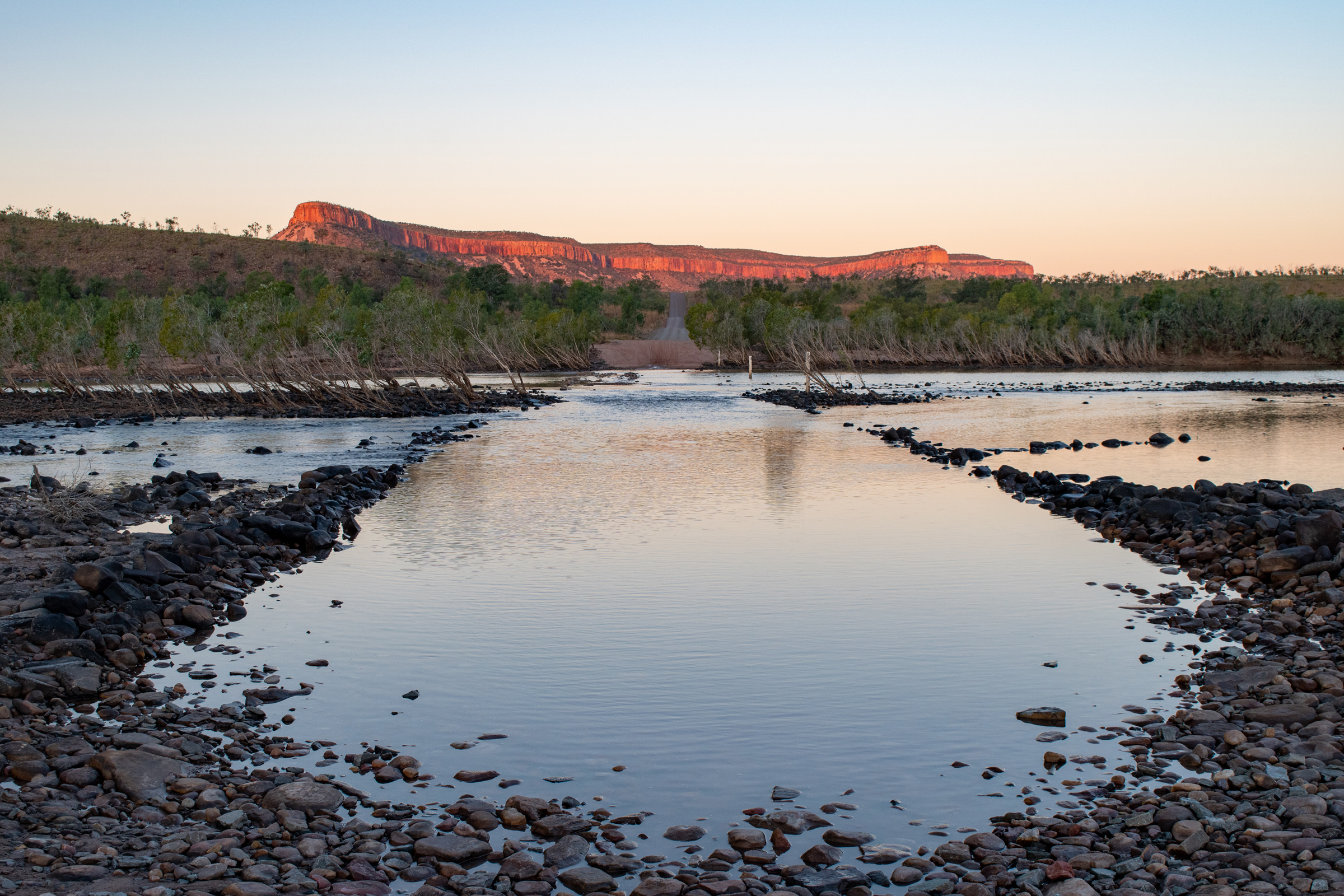Gibb River Road: The Kimberley’s Biggest Adventure

The Gibb River Road, also known as the Gibb or GRR, is the most iconic track of the Kimberley region in northwest Australia. Once (and to a lesser degree still) a stock route for cattle stations to the port towns of Derby and Wyndham, the Gibb is 660km of remote wilderness, showcasing some of the region’s best gorges, waterholes, and scenery. While at first this may sound like too much action for caravanning, it is quite feasible provided you have the right setup. An offroad caravan and 4WD tow vehicle are highly recommended as you are likely to encounter numerous water crossings and some serious corrugations depending on the time of year you visit. Don’t have an offroad caravan? Don’t despair! There are sights at either end of the Gibb that are still reachable towing a standard caravan or as a day trip from the larger towns at either end of the track.
Heading west to east starting in Derby, here are the must-see highlights of the Gibb River Road.
Crocs and Caves
While not officially on the Gibb River Road, the slight detour to Windjana Gorge and Tunnel Creek is well worth it. The road from Derby up to the turn-off is sealed, then the track in, while unsealed, is usually in good condition with minimal corrugations. If the track isn’t in condition for towing, it is still easily reached as a day trip from Derby or Birdwood Downs Station, the westernmost station of the Gibb.
Windjana Gorge (Bandilngan) is a deep pool framed by high gorge walls that form part of the Napier Range, which was once an ancient barrier reef system approximately 375 million years ago. There is a walking trail through the gorge (3.5km one way), but most visitors come here for the crocodiles. It is one of the best places along the Gibb to see freshwater crocodiles as they float lazily in the water or sun themselves on the banks or exposed rocks and logs. There is a National Parks campground here with basic toilet facilities.
Approximately 35km south of Windjana lies Tunnel Creek (Dimalurru), one of the more adventurous attractions along the Gibb. You will need a good torch and shoes that can get wet. The 750m trail involves walking, sometimes wading or even swimming, through a cave system, which can be pitch-black. While there are crocodiles here, they are the freshwater kind which are not aggressive unless provoked. The far end of the tunnel offers a peaceful respite and, for the keen eye, ancient Aboriginal artwork. Tunnel Creek is also part of the Pigeon Heritage Trail, the setting for the compelling story of Jandamarra (also known as Pigeon), a Bunaba man who became an outlaw due to conflict with European settlers in the late 1800s. Tunnel Creek is where Jandamarra’s saga met its dramatic end when he was fatally wounded during a shoot-out with the police.

The Belle of the Gibb
Many consider Bell Gorge one of the highlights of the Gibb, and rightly so — this multi-tiered waterfall is magnificent. However, due to its popularity, during the peak season rangers occasionally have to close the car park when it gets to capacity, so make sure you get in early during busier months. Bell Gorge is a 30km detour from the Gibb with a National Parks campground about 20km in. Another nearby camping option is Imintji Store, which offers unpowered camping with great facilities (large sites, toilets, showers, barbecues, a fire pit, and picnic tables). The walk to Bell Gorge is fairly easy until you get to the falls, where the track then requires you to navigate rock-hopping or wading through a flowing creek and a steep walk down into the gorge. You can always admire the falls from the top but much more awaits at the bottom: a great swimming hole, plenty of rock space to relax on, and waterways to explore further downstream.
Stops Along the Way
Adcock Gorge and Galvans Gorge are small detours from the main track and can easily be done on the way elsewhere. Adcock Gorge does require a bit of offroad driving and therefore may not be van-friendly, but the car park for Galvans Gorge is just off the Gibb and has plenty of space for vans. Being one of the lesser-known gorges of the Gibb, Adcock Gorge is one you’re more likely to have to yourself. Galvans Gorge is a short 1km walk from the car park, and timing is key: the area around the gorge and swimming hole is fairly small and can easily fill up if there’s a tour group or two there. Nevertheless, it is a picturesque waterhole with a large, iconic Kimberley boab towering over it. Here you’ll find a great example of the Wandjina-style of Aboriginal rock art; swim to the right of the falls and have a look under the overhang.

Worth the Effort
Manning Gorge at Mt Barnett Roadhouse simply cannot be missed; it is easily one of the most spectacular of the region. Being one of the longer walks, it is recommended to allow for at least a half-day here. Mt Barnett Roadhouse offers day-visit passes plus caravan-friendly camping in a large campground next to the Barnett River, convenient for a quick cool down on a hot day.
The walk itself to the gorge is part of the experience. It starts with a walk/swim through the Barnett River; floating containers are provided to keep personal items dry. From there, the track takes you through classic undulating Kimberley landscapes. Just when you start wondering how much further your legs can take you, you come around a corner, and there it is: Manning Gorge in all its grandeur. It is a massive area with a large swimming hole, impressive waterfall, plenty of lounging space, and overhangs with Aboriginal art to discover. It is one of those places where you can easily lose a few hours exploring or simply sitting back admiring the beauty.
Explorer’s Delight
Mt Elizabeth Station is one of the few working cattle stations along the Gibb that is open to visitors. With its numerous offroad tracks, it is a favourite among avid four-wheel-drivers. Visitors often rave about Wunnumurra Gorge for its picturesque waterhole and abundance of Aboriginal art.

An Unassuming Respite
Ellenbrae isn’t usually high on people’s lists for stops along the Gibb, and while you won’t find any breathtaking gorges here, it is still worth at least calling in. Ellenbrae has lovely green lawns (a welcome break from all the red dust!), a natural campground with quirky amenities, a couple small waterholes, and quite possibly the best scones in the Kimberley!
An Old Favourite Given a New Life
Home Valley is a well-known Kimberley station that almost didn’t see past the 2020 season. After a change in ownership, it wasn’t certain if and when they were going to open again, but by the second half of the 2021 season they were back in full swing. Home Valley is one of only two stations that offers powered campsites (El Questro being the other one) at the Homestead. The other camping option is bush-style camping along the Pentecost River. In addition, they have plenty of tours on offer and a popular bar and restaurant.
Quintessential Gibb
Being east of the Pentecost River, El Questro Station is usually one of the first places to open after the wet season as it is easily accessible from Kununurra. There is a water crossing to access the station; although it tends to recede fairly early, it is always wise to check accessibility with the station beforehand. As mentioned previously, powered campsites are available here and while El Questro does offer private riverside camping, they are not caravan-accessible; therefore, caravanners are limited to the homestead campground.
Similar to Home Valley, there is an abundance of tours and activities, as well as plenty of self-guided options. For those with a high-clearance vehicle and a good level of fitness, El Questro Gorge is a must. It’s a challenging walk that involves lots of clambering up and over boulders but the idyllic waterfall at the top makes it well worth the effort. For those who want something a bit more low-key, Zebedee Springs is the way to go. A short, easy walk leads to a multitude of thermal pools under the shade of Livistonia Palms, perfect for the ultimate relaxation. Be aware that Zebedee Springs is only open to the general public 7am-12pm. Lastly, for those with 4WD experience, Branco’s Lookout offers superb views of El Questro and beyond.
Caravanners certainly don’t need to miss out on this incredible adventure as the Gibb gradually becomes more accessible. Regardless, it is still predominantly an unsealed road and mishaps can, and do, happen, as evidenced by the several broken-down caravans we saw along our Gibb journey. The most important piece of advice, just like with towing on any rough terrain, is to take it slow. There is lots to see along the Gibb, and depending on your timeline, you most likely won’t be able to see it all. By making a realistic itinerary, we were able to travel at a more sensible pace and avoid any mechanical issues such as flat tyres or a bent chassis, which made for a more enjoyable and stress-free trip for not only ourselves but other travellers with whom we shared the road. The one thing we couldn’t avoid, however, was the dust! Nevertheless, by the time you finish the Gibb you’ll be carrying more than just extra red dust with you; you’ll have the memories of traversing a landscape unlike any other on Earth, memories that will last a lifetime.

Travel Planner
Time of Year: The Gibb is usually accessible from April to November, but that is highly dependent on the wet season. Timing is everything for the Gibb, and sometimes it simply comes down to luck. Early in the season, the waterholes will be at their best, but some places may still be closed due to being inaccessible. After a good wet, some stations and attractions might not open until June or later. The middle of the season (June–August) usually will have the best weather — dry with warm days and pleasant nights — but it is also when the Gibb will be at its busiest. Late in the season, you can be fairly confident that everything will be open, but some waterholes may have dried up and the roads are likely to be rough.
Accessibility: As is a common story with many 4WD tracks around Australia, the Gibb is slowly but surely being bituminised. Nevertheless, it is still mostly unsealed, so the condition of the track changes regularly. The best sources for information on the current state of the track are the Derby Visitor Centre (Ph: 08 9191 1426) and National Parks Office (Ph: 08 9195 5500).
Supplies: Supplies are few and far between along the Gibb. It is advisable to stock up for the entirety of your journey at either Derby or Kununurra. Fuel and a small selection of supplies are available at Imintji Store (diesel only), Mount Barnett Roadhouse, Drysdale Station, and Gibb River Station. Most of these stations have set opening hours and days, so plan accordingly. When calculating fuel requirements, don’t forget the turn-offs; those distances can add up, especially when towing. The Gibb is notorious for tyre punctures, but most of this can be avoided by driving to the conditions and maintaining appropriate tyre pressure. Have at least one spare tyre with you (two if you are towing a dual-axle van). If you’re in strife, Nev from Over The Range Tyre Repair and Mechanical between Adcock and Galvans Gorges can most likely sort you out.
Camping: It is recommended to stick to official camping offered at stations, roadhouses, and National Parks campgrounds, as bush camping along the Gibb is quickly becoming a thing of the past. Since most of the land along the Gibb is privately owned by local stations, there are no official free camps and therefore doing so is at your own risk. You will also require a WA Parks pass to visit certain areas, such as Windjana Gorge and Bell Gorge.
Be crocwise: Like everywhere in this part of the country, it is essential to be crocwise at all times. Fortunately, most waterways are free from estuarine (saltwater) crocodiles, and, as mentioned previously, freshwater crocodiles are considered harmless unless provoked. There are, however, exceptions such as the Pentecost River. Therefore, it is crucial to heed warning signs: if signage at a swimming hole says “no swimming” or if in doubt, do not swim. It is simply not worth the risk.
Additional Sights
It can easily take a week or more to properly visit all the destinations mentioned in this article. If you are lucky enough to have a bit more time up your sleeve, here are some more options:
Mount Hart Station: You won’t find the awe-inspiring gorges and swimming holes that the Gibb is known for, but there are still some lovely spots to visit, such as Barker Pool and Dolerite Gorge. It is also usually one of the first stations along the Gibb to open, which makes it a great option when visiting early in the season.
Charnley River-Artesian Range Wilderness Camp: Run by the Australian Wildlife Conservancy (AWC), this caravan-friendly property acts as a wildlife sanctuary that you can explore on guided or self-guided tours. The nightly informational talk is a great way to learn more about the worthwhile endeavours of this organisation.
Emma Gorge: Part of the El Questro Station group but in its own separate area, Emma Gorge doesn’t have camping facilities, but it can easily be reached from El Questro or as a day trip from Wyndham or even Kununurra. The beautiful fern-covered gorge and icy pool will be a welcome sight at the end of the walk.
Mitchell Plateau: It is highly recommended to leave caravans at Drysdale Station for this one, but it is well worth the extra effort to see the famed Mitchell Falls as well as the other sights of the Mitchell Plateau. If all else fails, you can organise a scenic flight from Drysdale or Kununurra.
Kalumburu: A fisher’s paradise, you’ll find beach-side camping and warm hospitality here. This one will be hard to leave!







